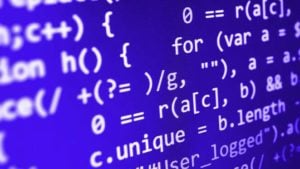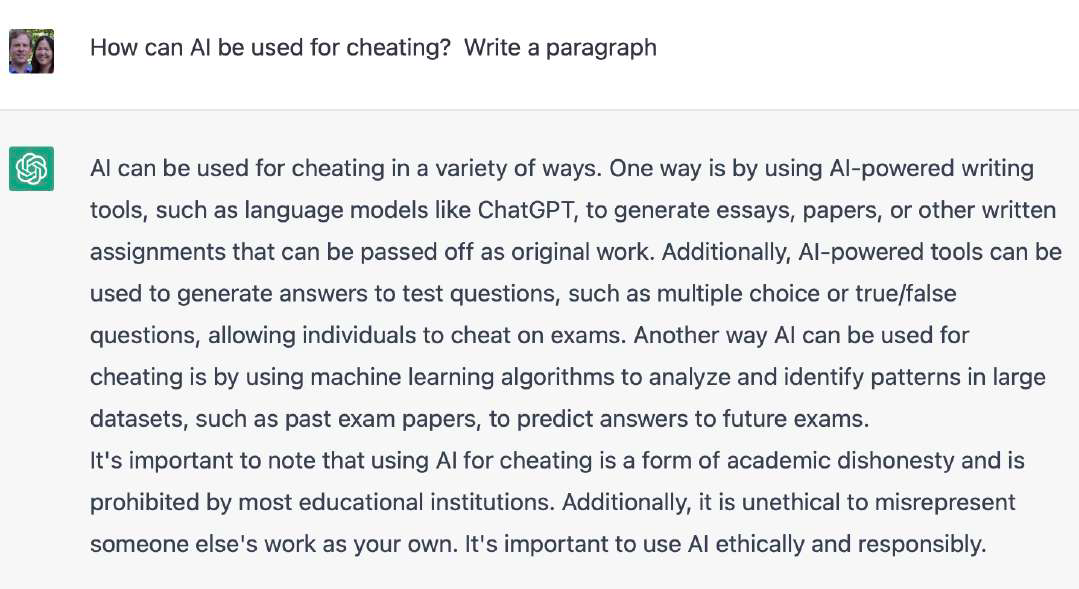 Currently, the educational world is being rocked about advances in artificial intelligence technology that are upturning ways students are being assessed and demonstrating their knowledge.
Currently, the educational world is being rocked about advances in artificial intelligence technology that are upturning ways students are being assessed and demonstrating their knowledge.
The AI Writing programs are dazzling and while there can be upsides to having this technology for free at your fingertips, there are definite problems and the challenge for teachers and schools will be to adjust to this new AI-reality without hurting students in the process. To see ChatGPT in action, check out the video below our link to sign up for a free account.
To see an example of ChatGPT in action, look at what happens when I ask the program to write a paragraph about how AI can be used for cheating.

Not surprisingly, free technology like this has been spreading like wildfire among students. With slight differences in rewording and editing, it may be next to impossible for anyone to detect that free AI programs were used to write it.
The bad consequences surely include a fraudulent education and schools trapped into graduating students who may not have deserved it.
The backlash and policy changes are already underway.
From Stephen Marche’s Atlantic Article, The College Essay is Dead:
“You can no longer give take-home exams/homework … Even on specific questions that involve combining knowledge across domains, the OpenAI chat is frankly better than the average MBA at this point. It is frankly amazing.” (Professor Kevin Bryan, University of Toronto)
The Washington Post responded with Here’s how teachers can foil ChatGPT: Handwritten Essays (can only be read if you have an account)
Unfortunately, that’s like using an atom bomb to kill a mosquito.
From a cognitive perspective, writing is one of the hardest things we can do. A student answering a question will need to retrieve information from long-term memory, prioritize and organize ideas, translate feelings and images into words, remember spelling, grammar, and letter formation information, and put that down on a page…often under timed conditions. Working memory is needed to juggle all the parts.
Students with dyslexia, dyspraxia, ADD, or autism may struggle with handwriting automaticity making the whole process 10 or 100x times as hard. Anxiety over not being able to finish may also swamp the whole process (including working memory) so that nothing or very little gets translated onto the page.
Many of these difficulties are not at this level of severity forever – but writing is almost always a late-blooming skill – and to demand what may be impossible will only further punish confidence and esteem to the point that even when these skills come online later, the psychic damage may already be done.
ALLOW TYPING OR DICTATION WITHOUT INTERNET ACCESS
The author of the Washington Post article actually suggested that typing in class without Internet access would be one solution to the AI dilemma, but the title of the article only mentioned handwritten essays.
Recently, we heard of a college student whose professor suddenly announced that all work had to be handwritten in class rather than any work being formed outside of class. He had significant dysgraphia and fortunately was able to advocate for his rights to be accommodated and he was able to change to a different course.
What of those who may be too embarrassed or encounter a less supportive student center? What about the more than 2/3’s of students who are not formally identified? These students may withdraw from classes, degrees, and even careers.
OPEN CHAT GPT CHEATS
Rather than assigning a topic based on a simple prompt that can be easily Chat GPT’ed, request further discussion based on points brought up by other students in class or specific aspects of your lessons. Ask for comments on certain slides, examples from the student’s life or experience.
Longer step-by-step projects are activities that involve real world problem solving and activities (like interviewing primary sources) or creation of multimedia presentations. To eliminate longer projects all together is to miss out on some the best opportunities for deeper learning.
Finally, having students present or defend their paper or project in class may also be a way of that a paper or project is really theirs and not just pasted into a word document. Can they answer questions about it or defend the position?
A reality of today’s academics is that many students consult non-academic sources for information whether it’s Google or Siri or Wikipedia. Some of the information may be right and some may be wrong.
It can be a useful thing considering different opinions on a subject; students still need to learn how to go deep with material, taking time to analyze, synthesize, and defend what they believe. Requiring the physical process of handwriting under timed conditions satisfies none of these higher goals.















Trackbacks/Pingbacks